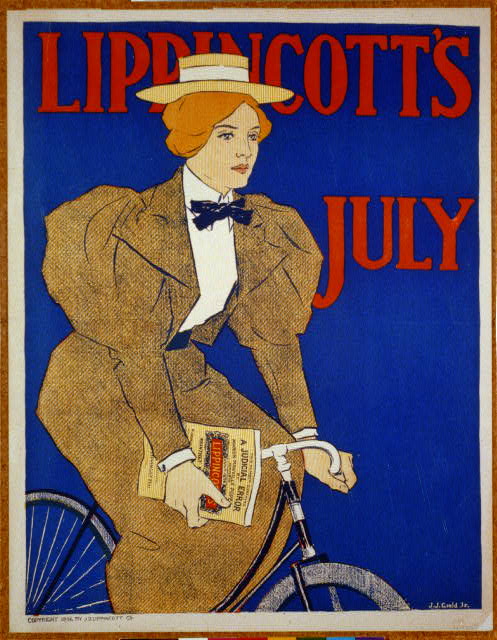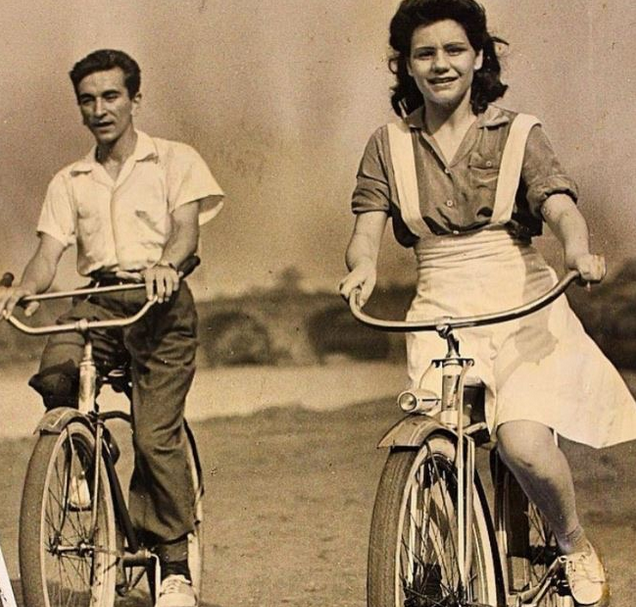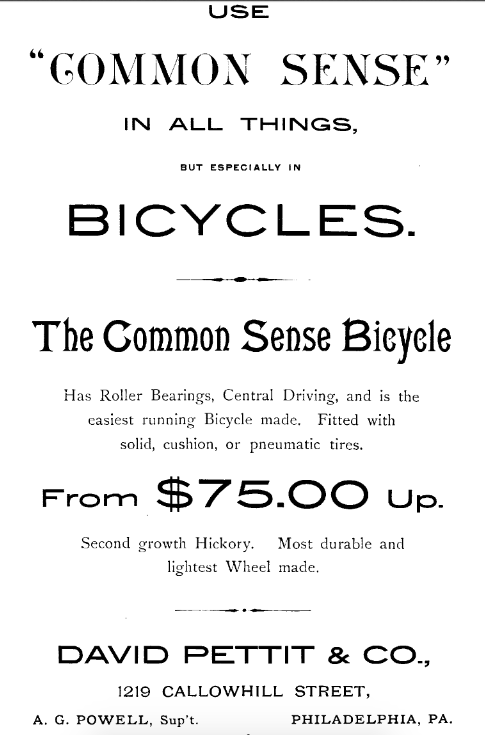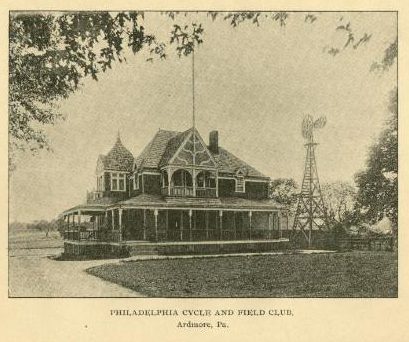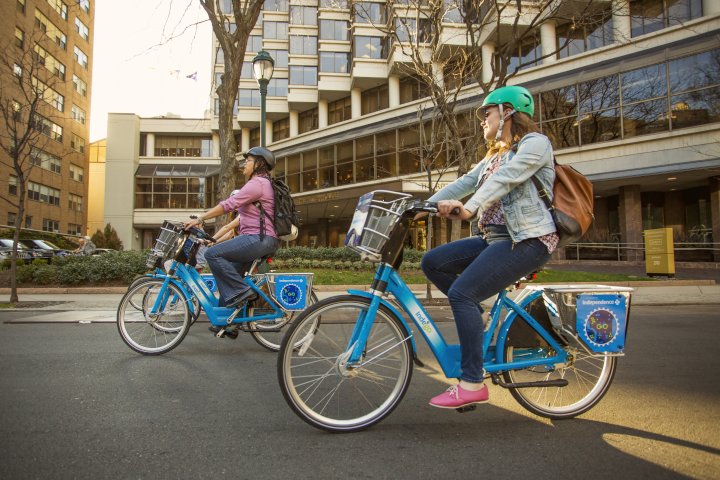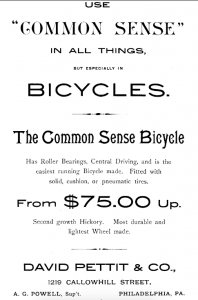Bicycles
Essay
Since the nineteenth century, bicycles have enamored the American public as tools of transportation, sport, exercise, and joy. The Philadelphia area has been intimately connected with the development of the two-wheeled, human-powered machine from its early appearance in North America to the adoption of bike-share programs and the blazing of interstate trail networks in the twenty-first century.
The first two-wheeler in Pennsylvania was crafted by a blacksmith in Germantown from the parts of a threshing machine in 1819, at the request of artist and antiquarian Charles Willson Peale (1741-1827). Technically a French-invented “velocipede,” the machine lacked a chain-drive transmission and brakes among other accoutrements. Peale, then nearly eighty years old, encouraged his sons and daughters to ride the 55-pound iron juggernaut and noted how they were able to travel—downhill, at least—“with a swiftness that dazzles the sight.” Not everyone was as enthusiastic. The same year that Peale acquired his velocipede, Philadelphia issued the first citation for riding on the city’s sidewalks, a spoke-stopping $3 fine. Even the museum proprietor soon lost interest in the heavy, ungainly two-wheeler.

This changed, however, with Philadelphia’s 1876 Centennial Exhibition. Among the varied exhibits was the English-designed “ordinary,” a machine with dissimilar wheel diameters that perched the rider several feet off ground. Spectators gathered to see this mechanical oddity in action, deftly demonstrated by Philadelphian John Keen. This was the high-wheel’s first public unveiling in the United States. As “ordinaries” became more widely available by the end of the decade, well-to-do riders gathered to socialize and formed local clubs, including the Philadelphia Bicycle Club (founded in 1879), the city’s first. The club promoted “the proper use of the bicycle and similar machines [as] a benefit to good health” and fellowship among cycling enthusiasts. Members shared advice on navigating gravel, dirt, or cobblestone roads that were also thronged with horses, carriages, and pedestrians. Members donned dandyish livery consisting of navy-blue flannel shirts trimmed in linen, brown corduroy breeches, and navy-blue knee stockings— – which served to invite even more ridicule by the press and public. Undaunted, similar associations formed in neighborhoods and towns across the region, from Ardmore’s Cycle and Field Club to the Wissahickon Wheelmen.
Safety Issues
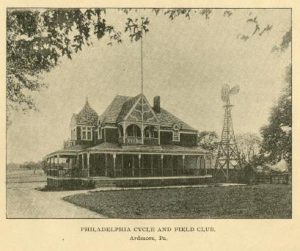
While the “ordinary” provided a much more controlled and enjoyable ride than its velocipede forebears, the machine remained extraordinarily unsafe due to the high center of gravity required of its riders. “Taking a header” by vaulting headfirst over the handlebars was a common accident befalling non-helmeted high-wheel operators.
It was not until the early years of the 1890s that, following innovations such as chain-drive transmissions, pneumatic tires, and reduced height, the Philadelphia area shifted into its first bike boom. Like the “ordinary,” these “safety” bicycles were publicly unveiled in the United States for the first time in Philadelphia, in 1891. With a marked decrease in the chances of cracking one’s cranium, a much shallower learning curve for operation, and a smaller price tag, these “safeties” provided a variety of riders— professionals, laborers, men, women— with a democratic means of travel, recreation, and sport.
Although many of the earliest cycling clubs were founded by and for men, the “wheel” of the 1890s became an engine of emancipation for women. “The new means of propulsion has found especial favor with the advanced and progressive femininity of the present age,” wrote Philadelphia historian Julius Friedrich Sachse (1842-1919) in 1896. “No class of persons has taken more readily to the wheel than the new or strong-minded woman.”
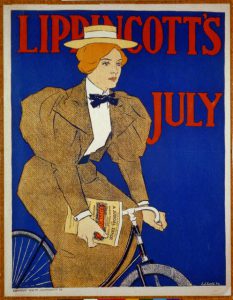
In the 1890s, custom confined many women to corsets, long gowns, and other voluminous garments, modes of dress wholly unsuitable for riding. For “New Woman” cyclists, this was far more than a sartorial or safety issue: this was a matter of sovereignty. If women could not determine something as personal as their own clothes, how could they demand public rights, such as getting the vote? Clad in divided skirts, knickerbockers, and bloomers, these “belles of the boulevard” stirred a national controversy. “Thoughtful people … believe that the bicycle will accomplish more for women’s sensible dress than all the reform movements that have ever been waged,” observed an 1895 issue of Demorest’s Family Magazine.
New manufacturing methods, many of which foreshadowed the assembly-line production techniques of the twentieth century, brought the price of bicycles within reach of millions of Americans. Demand sparked the rise (and fall) of several dozen bicycle manufacturers in the greater Philadelphia area alone, including Philadelphia’s Sweeting Cycle Company, Reading’s Packer Cycle Co., and the Haverford Cycle Company. Even the department store magnate John Wanamaker (1838-1922) joined the craze, with his 1897 Falcon model a particular hit. Like any new industry boom, a handful of upstarts flourished while many floundered. Founded in 1892, Philadelphia’s Common Sense Bicycle Manufacturing Company proved to be anything but, as the company folded the following year.
Mapping Routes
For a sense of the popularity of riding, consider that, beginning in 1896, the Philadelphia Inquirer published a series of bicycle routes, complete with a hand-drawn map, a narrative describing road conditions and landmarks of cultural or historical significance riders would encounter, and a coupon offering discounts on hotels and restaurants along the way. Many routes were confined to Philadelphia— such as “Philadelphia, Darby and Chester, A Pleasant 15-Mile Spin”—while others— “Harrisburg to Lewistown, En Route to Pittsburg”— crisscrossed the central and western regions of the state.
From the 1890s through the 1920s, a golden age of bicycle racing captivated millions of Americans, while men, women, and children used their two-wheelers for leisurely jaunts and exercise. Local printers and cartographers, cashing in on the craze, produced guides advising cyclists on the best way to navigate the region’s roughed and rumbled streets. In tandem with electric streetcars, the bicycle also upended business practices from mail delivery to police work. By 1894, only Chicago and New York had more bicycle-bound uniformed patrolmen than Philadelphia. So popular was the machine that, the following year, more than fifty thousand buggy and carriage horses were no longer needed in the City of Brotherly— and Bicycle— Love.
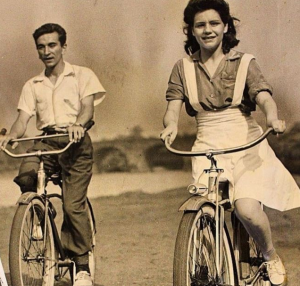
While the “safety” bicycle lived up to its name in many ways, the region’s dilapidated road network posed great challenges to cyclists, whether they were racing or commuting. To smooth out the city’s rutted roads, the Associated Cycling Clubs of Philadelphia (ACCP) published two pamphlets, “Improvement of City Streets” and “Highway Improvement,” in support of bicycle-friendly infrastructure projects, including macadamized surfaces. Petitions in favor of constructing bicycle paths in Fairmount were put to park commissioners as early as 1897. That same year, ACCP president William Tucker (1845-1930) petitioned Philadelphia’s Department of Public Safety to consider a “more careful and systematic use of water upon the highways” to reduce roads’ wheel-choking mud.
During the 1920s, public interest in cycling waned as automobiles— rendered affordable through many of the same manufacturing methods previously applied to bicycle production— emerged as the vehicle of choice for excitement, speed, and convenience. Gasoline rationing during the Second World War sparked a brief renaissance in bicycle-riding, but nothing approximating the near-hysteria of earlier decades. In the post-war period, the bicycle became primarily associated with children’s recreation, popularly conceived of as a vehicular prelude to owning an automobile.
During the environmental activism of the 1970s— marked by an increased concern over pollution produced by gas-guzzling four-wheelers— cyclists formed the Philadelphia Bicycle Coalition (PBC). In an effort to make the city more bicycle-friendly, the PBC campaigned for funding of bicycle infrastructure, sponsored city-wide rides, and produced publications such as 1974’s Commuters’ Bike Map for Philadelphia. The organization scored its first major victory in 1973, working with the Delaware River Port Authority to open the Benjamin Franklin bridge walkways to pedestrians and bicyclists, overturning a prohibition that had been in effect since 1950.
The Push for Bike Lanes
By the 1990s, municipalities began to designate bike lanes on city streets. In 1993, the PBC and Mayor Ed Rendell (b. 1944) planned for a 300-mile network of bike lanes and bicycle-friendly streets. Although the plan was never formally adopted, Philadelphia’s first bike lanes were installed two years later on a half-mile stretch of Delaware Avenue. Also in the 1990s, one of the PBC’s successful programs became a separate non-profit organization, Neighborhood Bike Works, and the citywide Philly Bike Ride began in 2009 and continued annually. Also in 2009, as the use of bicycles for commuting continued to grow in popularity, the PBC— renamed the Bicycle Coalition of Greater Philadelphia in 2002— worked to install buffered bike lanes on the major east-west arteries of Spruce and Pine Streets. Bicycle paths along Fairmount Avenue and along the Schuylkill Banks followed in 2013 and 2014. Central New Jersey unveiled buffered bike lanes in Cherry Hill in 2013, while Delaware–which the League of American Bicyclists named the third most bicycle-friendly state in the country in 2015–began construction of bike lanes along West and Washington Streets stretching from north Wilmington to the Riverfront in 2017.

In the region around Philadelphia, a consortium of organizations and municipalities created a trail network along the Schuylkill River from former carriage pathways, canal towpaths, and railroad corridors. Alternately called the Philadelphia to Valley Forge Bikeway and the Valley Forge Bikeway, the trail’s first stretch opened in 1979, spanning from Whitemarsh to downtown Philadelphia, following the right-of-way rail trails of the former Schuylkill Branch of the Pennsylvania Railroad. Further extensions of the trail during the 1980s included a 4.3-mile section in Montgomery County and the completed connection between Philadelphia to Valley Forge National Historic Park. Beginning in 2012, the renamed Schuylkill River Trail became integrated into the Circuit Trail project, part of the Delaware Valley Regional Planning Commission’s plan to create a single network of 750 miles of trails across nine counties in southeastern Pennsylvania and southern New Jersey. By 2016, more than 60 miles of the Schuylkill River Trail had been completed, with a planned goal of 130 miles connecting Philadelphia to Pottsville, linking the region’s urban, suburban and rural communities.
In 2009, the Northern Delaware Greenway Trail was completed, linking Wilmington, Alapocas Run, and Bellevue state parks between the Delaware and Brandywine Rivers. The trail network, part of the larger East Coast Greenway project, spanned more than forty miles between Wilmington and the Maryland border. Upon completion, the East Coast Greenway was slated to run from Maine to Florida.
In the second decade of the twenty-first century, several cities in the Philadelphia region adopted bike-share programs to promote fuel-conscious travelling. Philadelphia’s Indego, launched in 2015, generated a larger ridership in its first year than similar programs in Boston, Washington D.C., and Denver. By 2016, Camden County and Collingswood instituted bike-share programs. In a 2016 survey conducted by Bicycling, the world’s leading cycling magazine, Philadelphia ranked as the fifteenth-most bike-friendly city in the United States, the culmination of a trend stretching back to the early enthusiasm of Charles Willson Peale and his children for the velocipede in the nineteenth century. The city’s Naked Bike Ride, first staged in 2010, again displayed the machine’s power of liberation. One of the largest such outings in the country, the event promoted positive body image and bicycle advocacy with participants in considerably less rigid attire than their elaborately festooned counterparts in the region’s first cycling clubs.
Vincent Fraley is communications manager for the Historical Society of Pennsylvania and writes the Philadelphia Inquirer’s weekly history column, Memory Stream. (Author information current at time of publication.)
Copyright 2017, Rutgers University
Gallery
Backgrounders
Connecting Headlines with History
- Camden County prepares to launch bike-sharing program (WHYY, May 9, 2012)
- Bikeadelphia: Philly gets some love for its 'bike-ability' (WHYY, December 24, 2012)
- Efforts to improve bike-friendliness in Delaware paying off (WHYY, May 1, 2013)
- The bike race chronicles: Manayunk's bike culture (WHYY, May 5, 2014)
- Bike sharing safer than riding personal bike, study finds (WHYY, March 8, 2016)
- SEPTA adding more bike racks to its Broad Street line (WHYY, March 13, 2017)
- Ex-Gov. Markell to bicycle across America for charity (WHYY, April 20, 2017)
- Many heed the call to Philly's Bike to Work Day (WHYY, May 19, 2017)
- Montco approves plan for 800 miles of bike paths (WHYY, August 14, 2018)
- Philly adds electric bikes to Indego fleet (PlanPhilly via WHYY, November 9, 2018)
- 'We can fix these bike lanes': Thousands petition Mayor Parker, City Council to demand concrete barriers (WHYY, August 16, 2024)
Links
- Historical Bicycle Routes (Rutgers University)
- The Cycling Clubs of Philadelphia (pdf, Library of Congress)
- Philadelphia Bicycle Club (Historical Society of Pennsylvania)
- America on the Move: The Development of the Bicycle (Smithsonian Institute Museum of American History)
- History of the Bicycle: a Timeline (Brown University)
- Dodging Bulls and Gunshots on New Jersey's Nineteenth-Century 'Bicycle Railroad' (CityLab, 2012)
- How Stressful Is It to Bike Through Your City? (Next City)
- New Look at Philly, Chicago, and NYC Shows Path to Bike-Share Equity (Next City)

